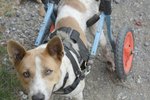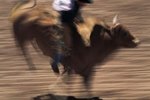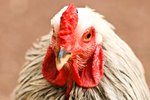When first pulled out of the package, a Hamilton harness is often a coiled, twisted mess. It may seem as though you will need a degree in textiles and design to figure out how to put it on your dog. However, identifying the parts of the harness and fitting it to your dog should really only take a few minutes. The Hamilton harness has many benefits, including avoiding pressure on your dog's windpipe and preventing escape and evasion. Once fitted, the harness will be good for years of use, provided your dog is done growing.
Take the harness out of the box or package. Lay it out on a table and untangle the straps.
Become familiar with the various parts of a Hamilton harness. There are five parts to the harness. The shoulder straps fit around the dog's shoulders. The girth strap goes around your dog's belly. The top strap connects the shoulder and girth strap and lays along your dog's spine. The chest strap connects the shoulder and girth straps along your dog's chest and goes between your dog's legs. The final piece is the D-ring to which you connect the leash.
Adjust the harness using the slider buckles to a rough estimate of what you consider your dog's size to be. Have your dog stand with its rump between your legs, facing away from you.
Place your dog's head through the hole between the shoulder straps. Pick up your dog's right front paw and place it through the hole created by the shoulder, girth, and chest straps. This places the chest strap along your dog's chest and settles the shoulder straps into place.
Buckle the girth strap around your dog's belly. Adjust the girth strap using the sliders until it has a snug fit. You should be able to slip a finger between the straps and your dog's body.
Adjust the shoulder straps so that they lay along your dog's shoulders, close to the base of its neck. Make sure the D-ring is in the middle of your dog's back.
Photo Credits
-
Dog image by Miron Kostiukov from Fotolia.com
Writer Bio
Since 2001, Kea Grace has published in "Dog Fancy," "Clean Run," "Front and Finish" and an international Czechoslovakian agility enthusiast magazine. Grace is the head trainer for Gimme Grace Dog Training and holds her CPDT-KA and CTDI certifications. She is a member of the APDT and is a recognized CLASS instructor. She's seeking German certification from the Goethe Institut.





